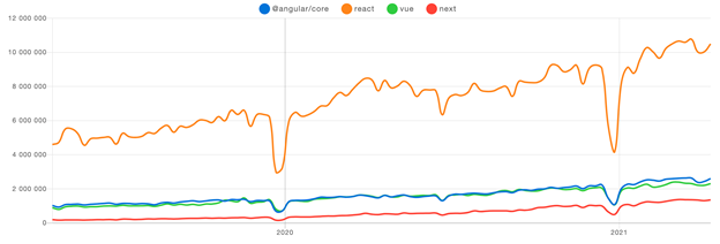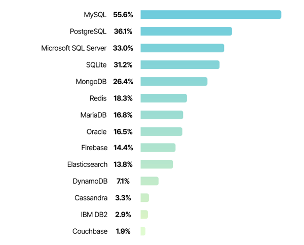
Subscribe
Be the first to know about our latest posts.
-
Service
Partners -
Sub-Service
website development, Contentstack, AWS, Azure, Adobe Experience Manager, Sitecore, Optimizely, Drupal
Ready to explore our services?
Technology Stacks for Web Development
Innovation is at the heart of business continuity. And it is the key to success when it comes to web application development. In the competitive world, now challenged by pandemic, web developers and companies are always refining their web development stacks based on latest tech trends and their own experience to enhance development processes and release the final product- a robust, scalable, and maintainable web application.
Technologies used for web development project plays a critical role when it comes to achieving your business objectives. The perfect selection will not only help you win your customers trust and business scalability, but meet your development requirements as well.
The tech stack is like erecting a solid foundation for your home. You don’t build the beautiful terrace first, you start from digging deep and laying the foundation. For establishing the right foundation, the selection of right languages, frameworks, or tools is utmost important.
To ease the process of selecting the right tech stack for your next web development project, this infographic highlights importance of web development, what exactly tech stacks are, why you should use them, some popular web development stacks to use in 2021, and factors to choose the right tech stacks.
Choosing Technology Stack for Web Development 2021
Tech Stack for Modern Web Development
As web and mobile spheres have grown more complex, more has become possible for enterprises aspiring to change the world with their digital ideas.
According to the Global Statshot Report 2021, more than 60% of the global population is online now, taking the total number of internet users to 4.72 billion. Moreover, there are a total of 1,936,758,000 websites up and running, engaging 4 billion user bases worldwide.
That equates to a massive spike in web users, which significantly leads to the importance of web development in the modern world.
Today, there are a total of 23 million people who are web developers. By 2023, numbers are projected to reach 27.7 million across the globe. That means web development means a lot more than what it was a decade ago. With social distancing, a norm, having a robust web presence is no longer an option, even for most traditional businesses. The enterprises that do not rely on digital presence to earn revenue leverage web presence to build credibility and increase awareness for the brand and initiatives. Such traditional businesses do not have robust in-house web maintenance capabilities - therefore, they should opt for a tech stack that requires minimal intervention at the post go-live stage.
Whereas those businesses whose bread and butter comes from the online presence require cutting-edge technology and, with that, a tech stack that keeps them ahead of the curve. Consider this: according to BigCommerce Survey, 96% of Americans prefer to go online for shopping. And it is expected that eCommerce websites will contribute to 22% of global retail sales by 2023.
As the global number of mobile devices is forecasted to reach 16.8 billion by 2023 and usage of web and mobile applications have exploded, companies are leaving no stone unturned to cater to their customers' needs, especially in this pandemic-stricken time.
What's coming out true is that only one bad experience can lead to distrust in brands, and that's why 77% of marketing professionals stated that it is one of the greatest weaknesses in winning customers' hearts.
As website stands as a prime face for your business, it is important to choose the technology stack wisely. To stay one step ahead, take the latest web development trends, techniques, and approaches into consideration. But to succeed in the market with a scalable, robust, and maintainable digital product, selection of technology stack matters a lot.
A technology stack is a collection of digital tools, frameworks, databases, and programming languages that are used to bring your web app to life. Web applications are made up of two components- the client-side (commonly known as frontend) and the server-side (commonly known as backend). One is responsible for UI, and the other is responsible for all the application logic needed for its functioning and operation.
Might Useful: Effective Tips to Improve the Value of a Website
You must pick the technology stack that is easy to test and maintain and provide regular updates with respect to the changing demands of the market, new security threats, and versions of technologies.
Frontend tech stacks generally include a combination of JavaScript, HTML, and CSS. According to the Stack Overflow Survey data of 2021, developers' interest is growing for JavaScript frameworks i.e., React, Angular, Vue.js. These three frameworks are widely popular for their high usability. React is majorly used by Node.js, Python, and Rails developers. Angular is used by Java, PHP, and C# developers, while Vue.js framework is widely accepted by the PHP, SCC, and Node.js developers.
Backend tech stacks include the Operating System on which the development is done, Web Server to process service requests from the client and respond back, Databases to store the app data, Programming Languages to build the application code, Backend Frameworks for faster and easier development.
According to the Popularity of Programming Language Index (PYPL), which examines the popularity of the languages based on Google searches, Python, PHP, JavaScript, Go, Java, etc., are leading the chart. The language index can help you decide which language is best for your next project coding.
After programming languages, you need to put focus on where to store all the data. As per Stack Overflow data, it shows that MySQL has maintained the topmost position on the chart, followed by PostgreSQL and Microsoft SQL Server. However, the trend shows a slight upward movement in the popularity of Firebase database, which left behind Elasticsearch this year.
Linux and Windows operating systems maintain the top positions in the chart as the most popular platforms for web development. While web servers, including Nginx, Apache, and OpenResty, are gaining huge traction among developers, according to Netcraft's statistics.
For backend frameworks, the most popular frameworks include Python (Django, Flask), PHP (Symfony, Laravel), JavaScript (NodeJS, MeteorJS, ExpressJS), and the list goes on.
Popular Web Technology Stack 2021
In 2021, the post-pandemic time, we've entered a new world where technology stacks are core vitals and dominate the web development space. Choosing the latest web technology stacks 2021 for your web development project helps in improving your business presence and maximizing profitability as well.
The MEAN technology stack, combining MongoDB (NoSQL DB), Express.js (backend web framework), Angular.js (frontend framework), and Node.js (open-source cross-platform server), tops the best web stack 2021 list. The stack is widely used to build fast, high-performing, scalable web applications.
The MERN Technology stack, containing MongoDB (NoSQL DB), Express.js (backend web framework), React.js (frontend framework), and Node.js (open-source cross-platform server), has the powerful library and strong capability to use code concurrently on browsers and servers. The full-stack framework is known for its flexibility and performance-oriented nature to create dynamic single-page applications.
The LAMP technology stack comprises Linux (Operating System), Apache (Web server), MySQL (Database), and PHP (Coding Language). It is one of the widely recognized tech stacks used by open-source CMS including Drupal and WordPress. Its simplicity, power, and stability made the tech chosen for the new custom software applications.
The Python-Django technology stack is a combination of JavaScript, Python, Django, and MySQL database. It is the part of high-level Python language that accelerates development with a clean logic and design. Python language is object-oriented and is used increasingly in different kinds of software development projects.
The Ruby on Rails technology stack is an open-source, object-oriented web development stack that uses Ruby as a dynamic programming language. This tech stack supports the development of lightweight web applications.
The serverless technology stack is used to develop applications on the cloud environment. It has great benefits like the provisioning of services and tools by serverless computing platforms. You can quickly scale up to thousands of users whenever the traffic surges and scale down when resources are not in need.
Choosing the Right Technology Stack
To answer your question, "Which technology stack should I pick for my web development", it is important to consider the following factors.
Project Type and Size make the choice of technology explicit. For example, you could go for Python-Django tech stack for small size web applications. Medium-size businesses require more functions; hence, full stacks like MEAN and MERN would do the job. On the other hand, large application sizes require a selective range of core technology stacks, including ReactJs, AngularJS, or Ruby and Rails, etc.
Time to market is yet another crucial factor to consider while working on your web development project. You should go for well-adapted tools and frameworks that allow smooth third-party integrations to expedite the development. MEAN technology stack is the most suitable to reduce the development time for your time-bound projects.
Scalability is very useful to support your business expansion. Angular and Node.Js are the best frameworks that help your web applications become scalable. You can either choose MEAN web technology stack or select Angular and Node.js tools.
Development and Maintenance Cost should be considered as one of the high priorities for your web development project. Selection of popular technology stacks offers two benefits; you will find developers easily, and there will be less burdensome of building or maintaining the product.
Integration with Third-Party Services is one of the crucial needs for today's web development. To allow communication between other applications and services, you should facilitate smooth API integrations.
The bottom line – Selecting the right technology stack for your web development is just as important as selecting the right developers to manage and make the best digital product out of it. As technology continues to advance, so will the tools and technology stack.
Refine your tech stack that best suits your development and market needs to thrive in the modern web world. Get a consultation today.





